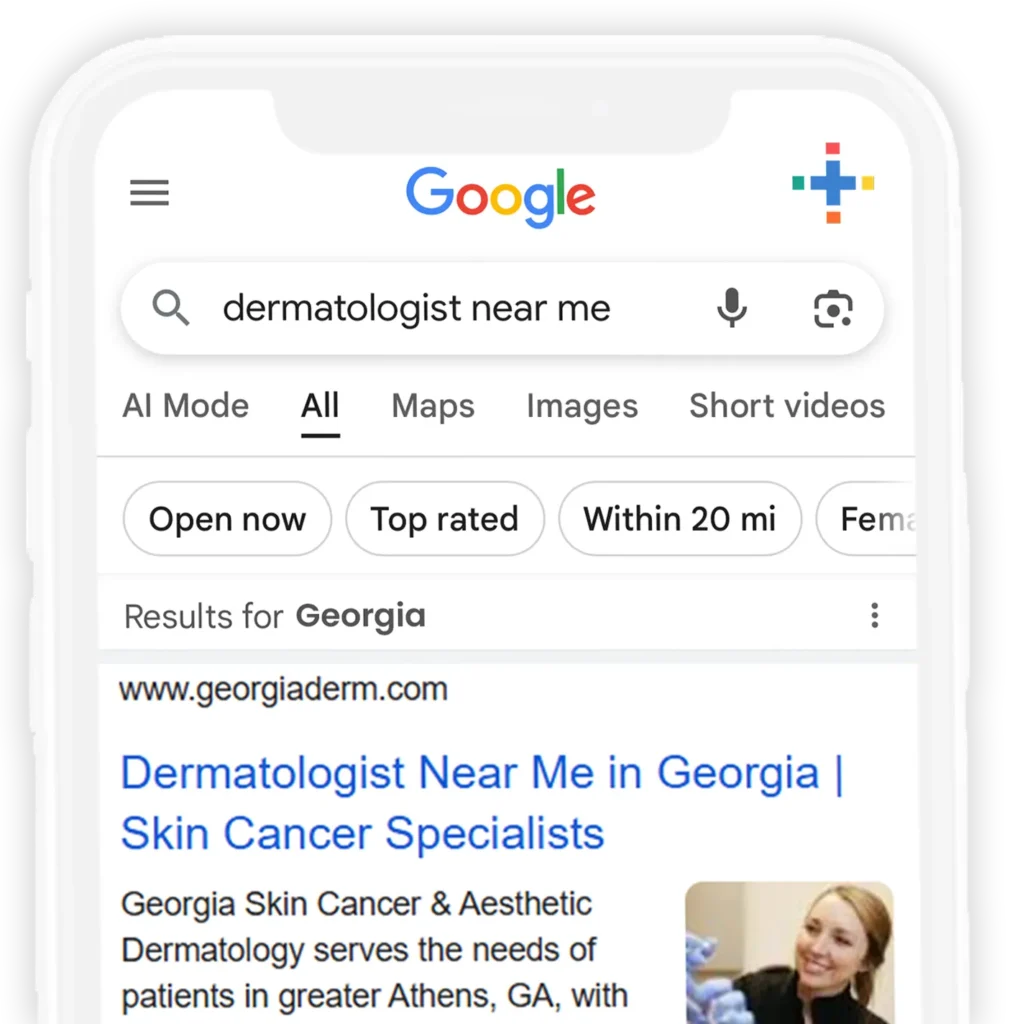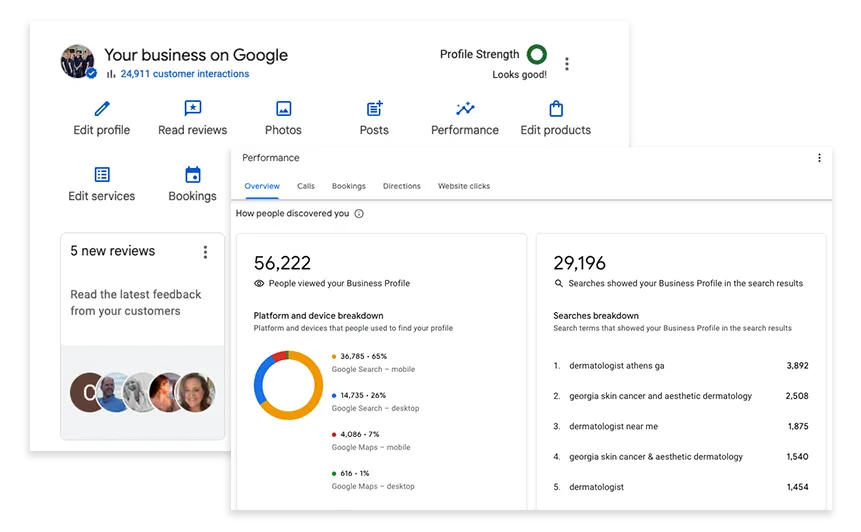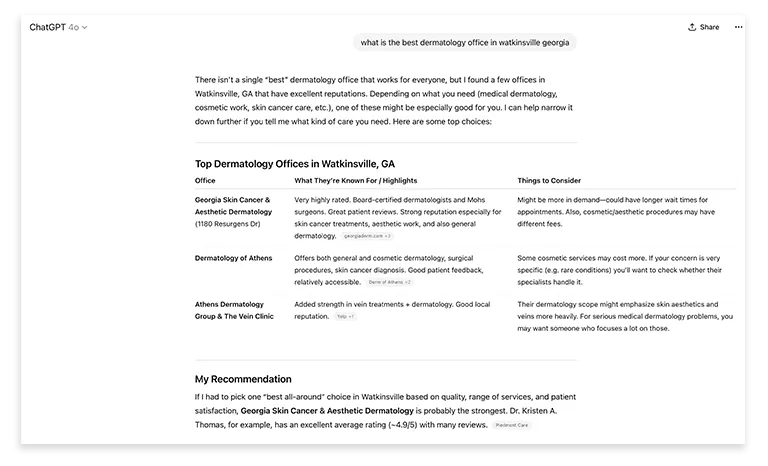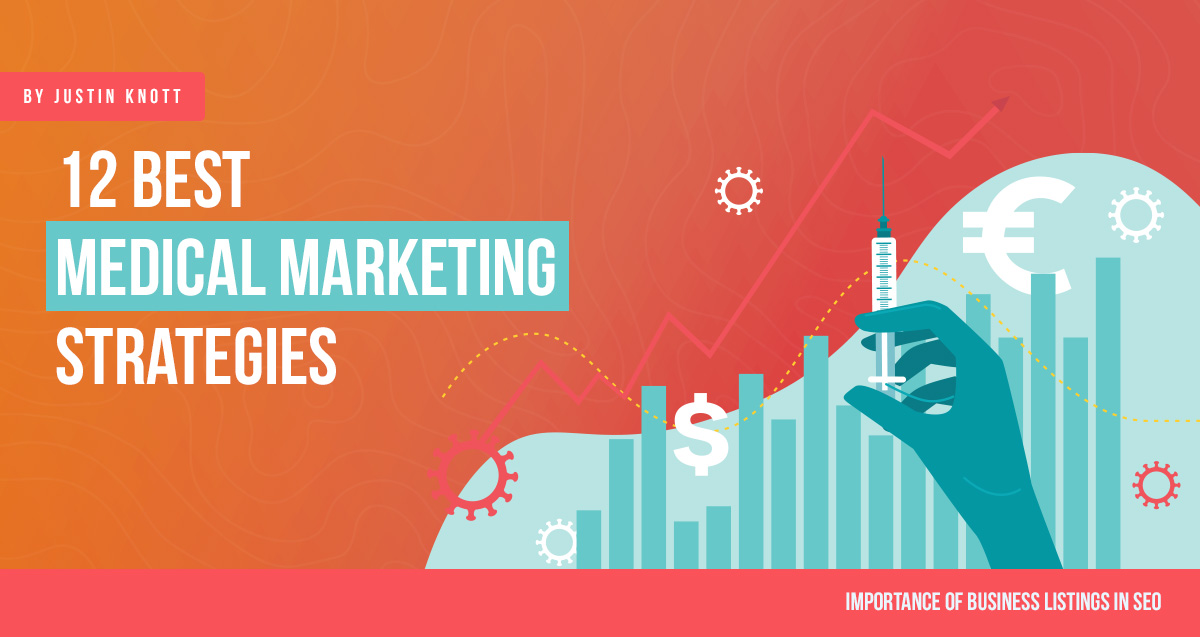Offering exceptional dermatologic care isn’t enough if patients can’t find you online. In today’s digital-first world, Search Engine Optimization (SEO) is the foundation of growth. Whether your practice focuses on medical dermatology, aesthetic treatments, or surgical procedures, ranking highly in search engine results and AI overviews is no longer optional; it is essential. When someone searches “acne dermatologist near me” or “Botox in [city],” your practice must appear. These are high-intent patients ready to take the next step. Without an optimized site, they will book elsewhere.

3 Key Takeaways for Dermatology SEO
- SEO Turns Visibility Into Patient Growth. A well-optimized dermatology website helps your practice rank for high-intent searches like “acne treatment near me” or “Botox in [city],” converting online visibility into real patient appointments.
- Local and Technical SEO Build Trust and Authority. From optimized Google Business Profiles and fast-loading pages to schema markup and consistent reviews, every detail strengthens your practice’s reputation and discoverability.
- AI Visibility Is the Next Frontier. As Google’s AI Overviews and ChatGPT results are reshaping search, Dermatology practices that create structured, trustworthy, and patient-focused content will stay visible across both search engines and AI platforms.
Ready to see your dermatology practice rise in search results? Our healthcare SEO experts can help you attract more patients, boost visibility, and stay ahead in the age of AI. Book your free Dermatology SEO strategy consultation today.
Table of Contents
- Why Is SEO Essential for Dermatology Practices?
- What Makes SEO Different in Dermatology Compared to Other Specialties?
- What Are the Biggest SEO Challenges Dermatologists Face?
- How Does Local SEO Attract New Patients?
- What Role Do Service Pages Play in SEO?
- How Important Are Provider Bio Pages?
- Why Does Content Marketing Matter for Dermatologists?
- What Technical SEO Factors Should Practices Prioritize?
- How Do Reviews and Reputation Impact Rankings?
- Is SEO a One-Time Project or an Ongoing Process?
- What Kind of Results Can Dermatology SEO Deliver?
- How Do I Know If It’s Time to Re-Evaluate My SEO?
- How Does AI Visibility Work for Dermatology SEO?
1. Why Is SEO Essential for Dermatology Practices?
Dermatology is one of the most competitive specialties in the healthcare field. Most patients compare providers online before making a call. Without SEO, your practice risks being invisible while med spas, chains, and larger facilities dominate search results. Having a clear dermatology marketing strategy for your practice can help you move forward with confidence and less stress.
2. What Makes SEO Different in Dermatology Compared to Other Specialties?
Dermatology is visual and consumer-driven. Patients want proof of outcomes before booking. That means SEO must combine educational content, such as information on conditions and treatments, with inspirational content like before-and-after photos, videos, and patient stories to both rank and convert.
3. What Are the Biggest SEO Challenges Dermatologists Face?
Dermatology practices face several common SEO challenges that can significantly limit their online visibility and patient growth. Many struggle with outdated or slow-loading websites that frustrate visitors and hurt search rankings. Poor mobile optimization is another barrier, particularly since many dermatology searches now occur on smartphones. Practices often lack service-specific landing pages, making it more challenging to capture patients searching for treatments such as acne care, Botox, or Mohs surgery. Incomplete or inconsistent directory listings further weaken local SEO signals, while a shortage of reviews and social proof undermines trust and credibility. Finally, even when practices invest in content, blogs are frequently disconnected from patient acquisition strategies, leaving valuable search traffic untapped and unconverted.
4. How Does Local SEO Attract New Patients?
Most bottom-funnel dermatology searches include a location qualifier, such as “near me” or “in [city].” Local SEO ensures that you appear in relevant search results. Key tactics include:
- Optimizing and verifying your Google Business Profile
- Keeping NAP (Name, Address, Phone) consistent across directories
- Adding services, photos, and posts to GBP
- Generating fresh reviews from real patients
Local SEO ensures your practice appears in these searches by optimizing and verifying your Google Business Profile, checking your contact information and correcting errors across directories, remembering to add new services and photos, and generating new patient reviews. These efforts enhance local visibility, making it easier for patients to locate and select your practice.
5. What Role Do Service Pages Play in SEO?
Every high-value treatment, from acne and Mohs surgery to Botox and laser resurfacing, should have its own dedicated page. These pages should target service and location keywords, include detailed procedure information, showcase HIPAA-compliant before-and-after photos, and feature FAQs, along with clear calls to action, such as “Schedule a Consultation.”
6. How Important Are Provider Bio Pages?
Very important. Patients often search for dermatologists by name. Optimized bio pages should highlight each provider’s credentials and specialties, feature professional headshots, showcase patient reviews and testimonials, and include easy scheduling links that make it simple for prospective patients to book an appointment. This builds trust and ensures that your providers appear in both branded and organic search results.
SEO is just one aspect of marketing for dermatologists. Read our blog about dermatology marketing strategies to learn how to elevate your online visibility, attract more patients, and grow your practice.
7. Why Does Content Marketing Matter for Dermatologists?
Blogging with intent allows your site to answer real patient questions. For example:
- “Is microneedling safe for darker skin?”
- “How to treat melasma in summer”
These long-tail keywords build authority, attract organic traffic, and establish your providers as trusted experts. By consistently publishing targeted content, your practice can enhance search visibility and establish lasting trust with prospective patients.
8. What Technical SEO Factors Should Practices Prioritize?
Technical SEO ensures your website is fast, secure, and easy for search engines to crawl. Key priorities include maintaining full mobile responsiveness, keeping page load times under three seconds, using HTTPS for security, and implementing schema markup to highlight services, locations, and patient reviews.
9. How Do Reviews and Reputation Impact Rankings?
Reviews are both a ranking factor and a conversion booster. More reviews on Google, Healthgrades, RealSelf, and Yelp send trust signals to both patients and search engines. Encourage reviews using your reputation management tools and always remain HIPAA-compliant.
10. Is SEO a One-Time Project or an Ongoing Process?
SEO is a continuous process. Algorithms and platforms evolve, competitors update strategies, and search trends shift seasonally. Dermatology practices should view SEO as an ongoing growth engine, rather than a one-time project.
11. What Kind of Results Can Dermatology SEO Deliver?
When executed correctly, SEO enhances traffic, increases lead quality, and boosts conversions. For example, one Intrepy MedSpa client saw a 79% increase in organic traffic and a 46% reduction in cost per lead after restructuring service pages and optimizing content.
12. How Do I Know If It’s Time to Re-Evaluate My SEO?
If your practice is stuck on page two or three of Google or if your website traffic is not converting into appointments, it may be time for an SEO refresh. Common signs include high bounce rates, low call or form submission volume, an outdated design or poor user experience, and a weak presence in Google’s local search results.
13. How Does AI Visibility Work for Dermatology SEO?
In 2025, search is evolving. Google has introduced AI Overviews (summarized answers that appear above traditional listings), and other AI platforms like ChatGPT and Perplexity are generating their own answers. While organic rankings remain important, these new AI-driven results are beginning to influence how patients discover and choose providers. For dermatology practices, preparing for this shift means adjusting SEO strategies to be both search-engine and AI-friendly. Key steps include:
- Adding structured data (code) for dermatology services (e.g., acne treatment, Botox, Mohs surgery) and for provider profiles to help AI systems understand your expertise.
- Writing FAQ-style content that answers common dermatology questions, such as “Is microneedling safe for sensitive skin?” or “When to request a skin biopsy” in clear, concise language that AI can cite.
- Building content clusters around conditions and treatments, such as acne → diagnosis → treatment → before-and-after results, to signal topical authority.
- Highlighting trust signals such as board certifications, patient reviews, and HIPAA-compliant before-and-after galleries is essential, as AI systems increasingly factor credibility into what they surface.
By aligning your content with both patient intent and AI interpretation, your dermatology practice can stay visible across the expanding range of search experiences.
Get Found and Get Chosen
SEO is no longer optional for dermatology practices; it is the difference between being visible and being overlooked. A strong SEO strategy makes your practice discoverable, builds patient trust, and drives measurable growth. At Intrepy Healthcare Marketing, we specialize in helping dermatologists create SEO strategies that connect with the right patients at the right moment. 📞 Ready to see how your SEO stacks up? Schedule your free consultation today and discuss your goals with our dermatology marketing experts.
About the Authors
By Tomi Barton Tomi Barton is the Chief Marketing Officer at Intrepy Healthcare Marketing, where she leads patient acquisition, ROI-driven digital strategies, and brand growth for medical practices across 40+ specialties. With training from Cambridge Marketing College and a Master’s in Internet Marketing from USF, she combines clinical literacy, marketing expertise, and AMWA-trained medical writing skills to create content and campaigns that build strong healthcare brands and measurable growth. She specializes in healthcare strategy, direct-to-patient marketing, AI visibility, and ROI optimization for physicians and specialty medical practices.
Co-authored by Megan Patton, Healthcare Content Development Specialist Megan is an experienced healthcare content strategist and writer at Intrepy Healthcare Marketing. She specializes in creating educational, high-converting SEO content for medical practices, bringing a deep understanding of patient search and funnel behavior.





